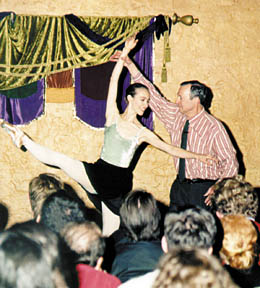Kenneth Laws Physics and the Art of Dance Video
Physics and Trip the light fantastic in a Pas de Deux

Amy Kohler and Kenneth Laws
In a small lecture room at the Atlanta City Ballet, ballerina Amy Kohler is demonstrating sequences of movements for the benefit of the audition, which includes not only physicists in town for the APS Centennial meeting last March, but local non-science residents as well. The purpose of the operation is not merely artistic appreciation: After each sequence, physicist Kenneth Laws analyzes the movements using physics principles to explain such phenomena as balance and the way torques are practical to produce rotational motion.
"The moving human body provides an intriguing opportunity to employ the laws of classical mechanics to visually accessible and interesting phenomena," says Laws. "Dance is a human movement that is particularly rich in diverseness and beauty." And he should know. For the last 20 years, he has been combining his life as a physics professor at Dickinson Higher in Carlisle, PA, with delivering lectures and demonstrations on the physics of dance. He believes such enquiry enhances understanding and appreciation of both disciplines, as well as improving the techniques of dancers.
Physics came commencement. Laws recalls condign interested in the subject field as a high school student, although he enrolled at the California Plant of Applied science intending to major in mechanical engineering. But a sophomore physics course convinced him that the world of physics was far more than fascinating and he opted instead to focus on that. And then ("because I didn't have annihilation amend to do," he quips) he went on to consummate an MS from the University of Pennsylvania and taught for a twelvemonth before going back to earn his PhD in solid state physics, this time from Bryn Mawr Higher. He joined the faculty of Dickinson Higher soon subsequently, and has been teaching there ever since.
Laws' passion for dance was ignited relatively late in life, afterward he'd already established himself in the physics profession. He took his showtime ballet grade at the age of 40, initially to exist virtually his children, then 5 and 7, who had just started ballet lessons at the Central Pennsylvania Youth Ballet. He started working backstage pulling the drape for performances, and while watching a pas de deux during one, he was so moved past its simple dazzler that "I concluded upwards with tears streaming down my face. It turned my life upside down." His son quit later a twelvemonth and a half; his daughter retired "at the ripe old age of 13 after a long and illustrious career," he says. Merely Laws couldn't give it up, and continued taking lessons, eventually serving as president of CPYB'due south Board of Directors. He even had the opportunity to perform in minor graphic symbol roles, including one of the suitor princes in Sleeping Dazzler.
A few years into his ballet studies, Laws noticed that the instructor was asking students to perform movements that seemed to be physically impossible - withal many young students were able to do them. He began investigating the physical principles and developing explanations for why dancers tin perform such feats. "Then the dance captured me start because of its beauty and the mode information technology works with music, and so I discovered the way physics applies," he says. Since then, he has published over 30 articles on the physics of trip the light fantastic in diverse scientific and trip the light fantastic publications, and somewhen authored The Physics of Dance in 1984, published by Schirmer Books - although only after Laws had collected 21 rejection slips from other publishers, a testament to his persistence. His faith in the project paid off: the book concluded upwardly selling over 10,000 copies and is currently out of print. [Laws is negotiating with Oxford University Printing to publish a new, updated edition next yr.]
The Physics of Trip the light fantastic toe was followed in 1994 past Physics, Dance and the Pas de Deux, co-authored by Cynthia Harvey, a former principal dancer with the American Ballet Theater in New York City, which included an accompanying video, as well every bit a chapter devoted to the physics of ice skating. Although neither book sold enough copies to generate a significant source of income, information technology did establish Laws' brownie in both physics and trip the light fantastic toe, and launched what has become almost a second career of traveling around the country delivering lectures and residency programs on the physics of dance. He teamed up with Kohler, a freelance dancer based in Chicago, last year, and hopes to continue the partnership despite her planned relocation to N Carolina to start her own trip the light fantastic company. "She's just the right size, shape and ability for me to work with, and she has the interest and personality needed to go with it," he says.
Through such presentations, which seem to appeal to scientists, dancers and the general public in equal measure, "Trip the light fantastic toe can be seen with a new perspective, physics can be seen in an unusual application, and the links betwixt scientific discipline and fine art are expanded," says Laws. Through it all, he has continued to teach at Dickinson. "Physics is my vocation and I enjoy it very much, but trip the light fantastic toe is my passion."
winchesterhishoupers.blogspot.com
Source: https://www.aps.org/publications/apsnews/199911/festival.cfm
0 Response to "Kenneth Laws Physics and the Art of Dance Video"
Post a Comment